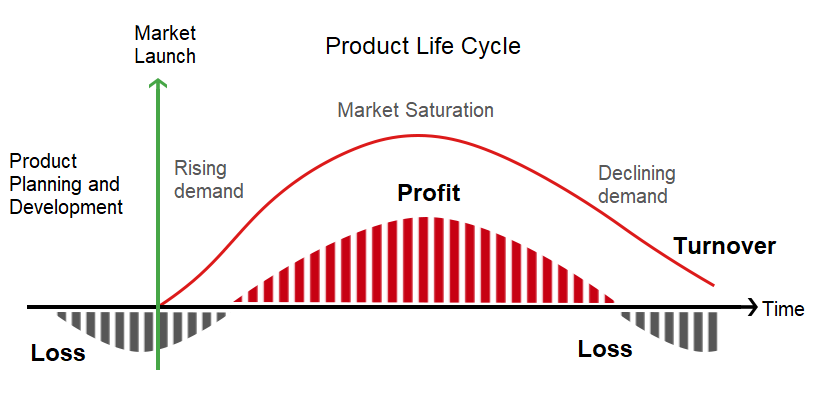
Table of Contents
How do you achieve maximum profit with a PIM system?
The product life cycle is a concept used by marketers to describe the stages of a product on the market - from concept creation to product degeneration. It is used to predict changes in demand, profit, costs and competitiveness. This makes it possible to develop an optimal strategy for market behavior.
| Phase | Target | Profit | Sales | Consumer | Expense |
|---|---|---|---|---|---|
| Concept | Search for a commercially successful idea | None | None | None | Low |
| Development | Creation of a production model | None | None | None | High |
| Introduction | Demand research, feedback | Low | Not large | Innovators | High |
| Growth | Conquering the market | High | Medium and growing further | Successors of innovators and early majority | Medium? |
| Maturity | Getting the most out of the market | High | Maximum | Majority | Low |
| Degeneration | Exit the market in time, launch a new product | Low | Low and decline drastically | Backward | Low and decline drastically |
Description and working principles of a PIM system
What is it?
A PIM system (abbreviation of "Product Information Management") is software for the centralized and synchronized management of product information in real time. The data complies with defined standards and formats and the product data is not contradictory and is easy to read.
How does a PIM work?
PIM systems work as follows:
- a uniform database is created and all product information is entered from various sources (ERP, Excel, PLM, etc.). The product information can be entered by different employees who deal with the products in all phases of their life cycle.
- the collected information is automatically or manually structured, categorized, improved and completed, translated into different languages and related to appropriate materials.
- after the creation of qualitative product information, it is published for further use through various distribution channels: print catalogs, Amazon or Ebay, online stores, mobile applications, etc.
The main task of PIM systems is therefore not to work with the product itself, but to work on the product information. This makes PIM software a good support for product support throughout its life cycle.

6 Phases of the product life cycle
Concept creation
Description
In the first phase of the product life cycle, opportunities for new product developments are sought by the company developing new ideas. The sources of these ideas can be consumers, partners and internal employees. The best ideas are analyzed from a commercial and technical perspective, and based on these analyses, the company selects one or a few ideas for implementation.
Main features:
- the absence of profit;
- relatively low costs;
- purely mental work and paperwork.
How can a PIM system help?
As early as the product concept creation phase, it is advisable to think about what product information may be important and what technical data should describe this product. What advantages will this product have and how will it differ from other products? It is also advisable to start working on the product descriptions at an early stage. This allows you to save a lot of time by preparing the product for market launch ahead of time. The creation of high-quality marketing texts is very time-consuming and can be well prepared thanks to a PIM solution, because a lot of product information can be collected and stored in the PIM system.
Product development
Description
Product development or "valley of death" is what many call this phase. As the development phase incurs large costs for the company, but there are no guarantees of a return on investment. Studies have shown that only one out of four products achieves commercial success.
The development process usually includes MVP development (minimum viable product) and its testing in a real-life situation, evaluation of results and improvements to the MVP. Development is completed when testing of the product's performance and customer evaluations indicate that the product is actually in demand.
Main features:
- high demand for labor, production capacity and time;
- severe liquidity shortage of the company;
- the product is introduced to the market for the first time;
- enormous costs.
How can a PIM system help?
During the product development phase, it is also necessary to work in parallel on qualitative product descriptions so as not to spend time on them when the product is already ready to be launched on the market. Rapid development and market introduction of new products (NPI - New Product Introduction) ensure a major competitive advantage for manufacturers. And this is exactly where a PIM can help. A PIM system makes it possible not only to start work on product descriptions ahead of time, but also to save time in preparing high-quality product descriptions and their translations and to publish the prepared information quickly on various channels.
In a PIM, all your product data needed for the product launch is stored in a single place. In addition, all important information created during product development, such as drawings, 3D models, product photos of prototypes, etc., can be stored in a PIM system like a repository.
Market launch
Description
The product is first sold to a small number of specially selected customers. As a rule, these are people who are trying out new products, who have already pre-ordered existing products and those who are keen to be the first to have a new product. If these customers give positive reviews, the company expands its sales channels.
Main features:
- the product must be marketed aggressively;
- low profit and trade turnover;
- weak competition;
- high costs.
How can a PIM system help?
During the market launch of the product, marketing must take place quickly and simultaneously through all possible channels - print catalogs, wholesalers, portals, online stores (own and partner online stores), websites, web applications, etc. A PIM system not only helps to distribute the standardized information through the necessary channels. It also makes it possible to increase the number of these channels without increasing their maintenance costs. If the sales channels are connected to a PIM system, synchronization and updating of product data will take place without a great deal of time. As a result, correcting errors will also take less time than without a PIM solution.
Growth phase
Description
Information about new products will go from mouth to mouth among consumers. Everyone wants to try the novelty, tell their friends about it and post the selfie on the networks. Competitors enter the market with better attributes and lower prices.
Main features:
- consumers know the product well;
- high dynamics of sales increase and profit growth;
- strengthening of competition;
- the product is significantly improved;
- price reduction due to increase in production volume and strengthening of competition.
How can a PIM system help?
Experience shows that large companies that have introduced a PIM system have increased sales by 25 percent annually. This is because it is easy to connect and maintain new sales channels to the PIM system. With a PIM, manufacturers using a PIM system can create more complete and accurate product information than those using ordinary sales channels, because key information can be updated and supplemented several times with a PIM system than without one. And it is already known that the customer is more likely to buy the product with a detailed and qualitative description.
Maturity phase
Description
In this phase, sales are still rising, but more slowly. Price wars arise, improvements cost more and more and bring less profit. Customers are not won through novelty, but with the help of price reductions, credits and diversification of the product.
Main features:
- the market is saturated, profits are falling;
- the peaks in sales have been reached;
- maximum competition;
- sharp reduction in product costs;
How can a PIM system help?
Completeness, usability, accuracy and timeliness in the provision of information about products, special offers, discounts and bonus programs increase consumer confidence, which also increases their loyalty. At this stage in particular, the quality of product descriptions is the deciding factor for the purchase. In a highly competitive environment, this criterion becomes particularly important.
Degeneration phase
Description
Slump in demand and profits. Market appearance of technically superior innovations and substitute products that customers prefer more than old products. Most competitors go bankrupt or leave the market. Product demand disappears completely or falls to a very low level. In the latter case, the product becomes a fetish for a small group, e.g. blacksmithing or the sale and repair of gramophones and gramophone records.
Main features:
- product costs slip below the break-even point;
- large productions are stopped;
- competitors leave the market en masse.
How can a PIM system help?
Procter & Gamble and Walmart can be taken as an example. After the PIM software was introduced in these companies, it showed that 3.7 percent and 2.5 percent of the products in their catalogs were out of date (they appeared in the catalogs but were not purchased). With a PIM system, the company can keep its product range up to date and maintain product catalogs, and can also use a large amount of collected product information for the following activities:
- the search for consumer patterns;
- Increasing the effectiveness of all sales aspects;
- Generating ideas for market entry with a new product.
Conclusions
The concept of product life cycle is a forecasting model that helps marketers to work out the optimal strategy of market behavior in order to get the maximum profit and understand when to withdraw the old product from sale and introduce the new one. PIM systems are aimed at automating work with information, which allows to relieve your employees from routine work and reduce the number of errors. The use of PIM software (e.g. AtroPIM) helps companies not only to save on labor costs, but also to increase sales through better quality of product information and its timely publication to the target audience.

